Mental Health Crisis: Examining Challenges Faced by Young People
VerifiedAdded on 2020/03/04
|5
|1568
|52
Essay
AI Summary
This essay provides a comprehensive overview of mental health challenges faced by young people. It begins by highlighting the prevalence of mental health issues, citing statistics on the rates of mental illness, psychological distress, and suicide risk among youth. The essay explores the impact of these issues on various aspects of young people's lives, including academic performance, social functioning, and substance abuse. It discusses the importance of early intervention and the need for effective mental health services tailored to young people. The essay examines the specific concerns of young people with potential severe mental illness, such as depression, stress management, and body image issues, and explores the factors that contribute to these concerns. It also touches upon the effectiveness of interventions and the challenges in translating research findings into real-world settings, emphasizing the need for comprehensive and multifaceted approaches. The essay references key research and provides insights into the complex interplay of factors influencing youth mental health, making it a valuable resource for understanding and addressing this critical issue.
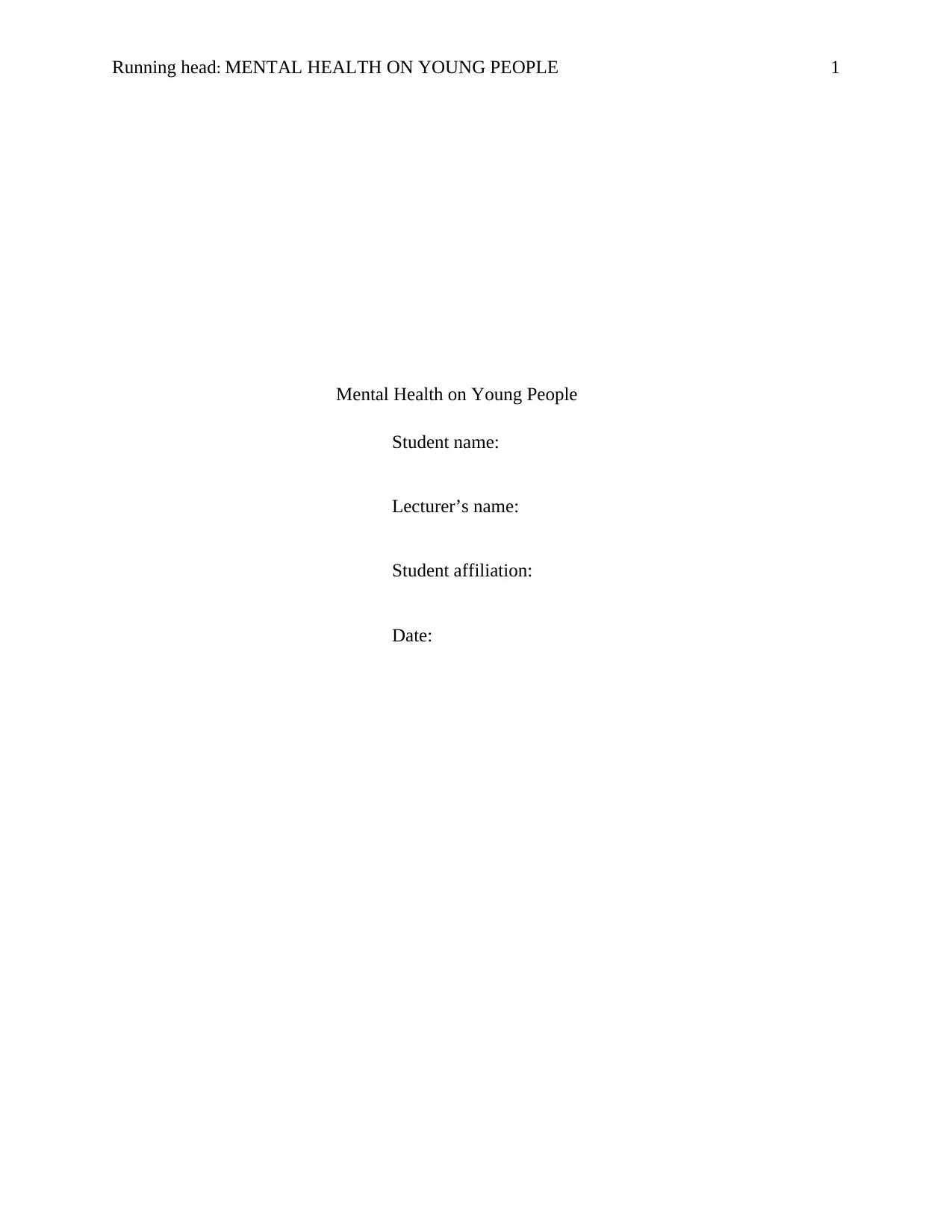
Running head: MENTAL HEALTH ON YOUNG PEOPLE 1
Mental Health on Young People
Student name:
Lecturer’s name:
Student affiliation:
Date:
Mental Health on Young People
Student name:
Lecturer’s name:
Student affiliation:
Date:
Paraphrase This Document
Need a fresh take? Get an instant paraphrase of this document with our AI Paraphraser
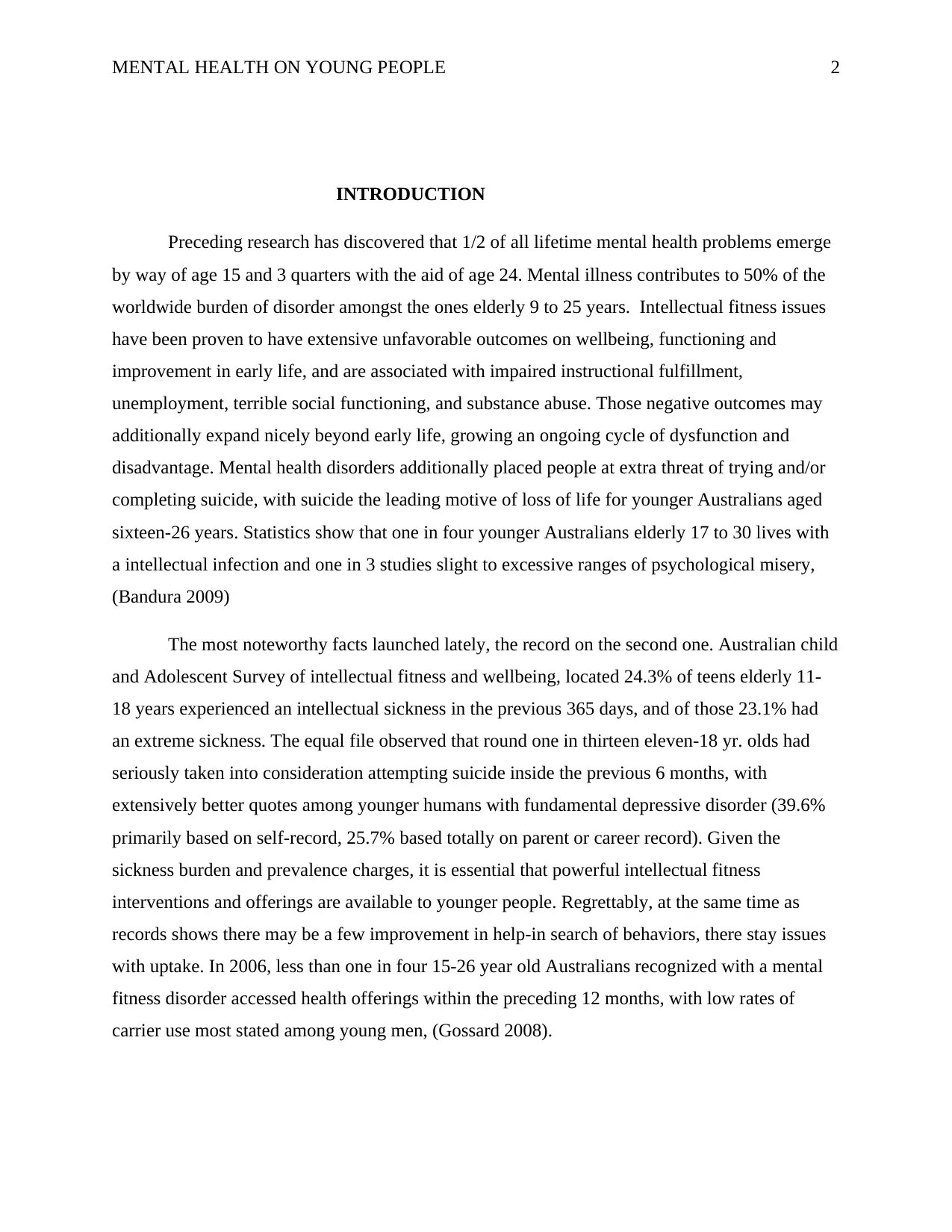
MENTAL HEALTH ON YOUNG PEOPLE 2
INTRODUCTION
Preceding research has discovered that 1/2 of all lifetime mental health problems emerge
by way of age 15 and 3 quarters with the aid of age 24. Mental illness contributes to 50% of the
worldwide burden of disorder amongst the ones elderly 9 to 25 years. Intellectual fitness issues
have been proven to have extensive unfavorable outcomes on wellbeing, functioning and
improvement in early life, and are associated with impaired instructional fulfillment,
unemployment, terrible social functioning, and substance abuse. Those negative outcomes may
additionally expand nicely beyond early life, growing an ongoing cycle of dysfunction and
disadvantage. Mental health disorders additionally placed people at extra threat of trying and/or
completing suicide, with suicide the leading motive of loss of life for younger Australians aged
sixteen-26 years. Statistics show that one in four younger Australians elderly 17 to 30 lives with
a intellectual infection and one in 3 studies slight to excessive ranges of psychological misery,
(Bandura 2009)
The most noteworthy facts launched lately, the record on the second one. Australian child
and Adolescent Survey of intellectual fitness and wellbeing, located 24.3% of teens elderly 11-
18 years experienced an intellectual sickness in the previous 365 days, and of those 23.1% had
an extreme sickness. The equal file observed that round one in thirteen eleven-18 yr. olds had
seriously taken into consideration attempting suicide inside the previous 6 months, with
extensively better quotes among younger humans with fundamental depressive disorder (39.6%
primarily based on self-record, 25.7% based totally on parent or career record). Given the
sickness burden and prevalence charges, it is essential that powerful intellectual fitness
interventions and offerings are available to younger people. Regrettably, at the same time as
records shows there may be a few improvement in help-in search of behaviors, there stay issues
with uptake. In 2006, less than one in four 15-26 year old Australians recognized with a mental
fitness disorder accessed health offerings within the preceding 12 months, with low rates of
carrier use most stated among young men, (Gossard 2008).
INTRODUCTION
Preceding research has discovered that 1/2 of all lifetime mental health problems emerge
by way of age 15 and 3 quarters with the aid of age 24. Mental illness contributes to 50% of the
worldwide burden of disorder amongst the ones elderly 9 to 25 years. Intellectual fitness issues
have been proven to have extensive unfavorable outcomes on wellbeing, functioning and
improvement in early life, and are associated with impaired instructional fulfillment,
unemployment, terrible social functioning, and substance abuse. Those negative outcomes may
additionally expand nicely beyond early life, growing an ongoing cycle of dysfunction and
disadvantage. Mental health disorders additionally placed people at extra threat of trying and/or
completing suicide, with suicide the leading motive of loss of life for younger Australians aged
sixteen-26 years. Statistics show that one in four younger Australians elderly 17 to 30 lives with
a intellectual infection and one in 3 studies slight to excessive ranges of psychological misery,
(Bandura 2009)
The most noteworthy facts launched lately, the record on the second one. Australian child
and Adolescent Survey of intellectual fitness and wellbeing, located 24.3% of teens elderly 11-
18 years experienced an intellectual sickness in the previous 365 days, and of those 23.1% had
an extreme sickness. The equal file observed that round one in thirteen eleven-18 yr. olds had
seriously taken into consideration attempting suicide inside the previous 6 months, with
extensively better quotes among younger humans with fundamental depressive disorder (39.6%
primarily based on self-record, 25.7% based totally on parent or career record). Given the
sickness burden and prevalence charges, it is essential that powerful intellectual fitness
interventions and offerings are available to younger people. Regrettably, at the same time as
records shows there may be a few improvement in help-in search of behaviors, there stay issues
with uptake. In 2006, less than one in four 15-26 year old Australians recognized with a mental
fitness disorder accessed health offerings within the preceding 12 months, with low rates of
carrier use most stated among young men, (Gossard 2008).
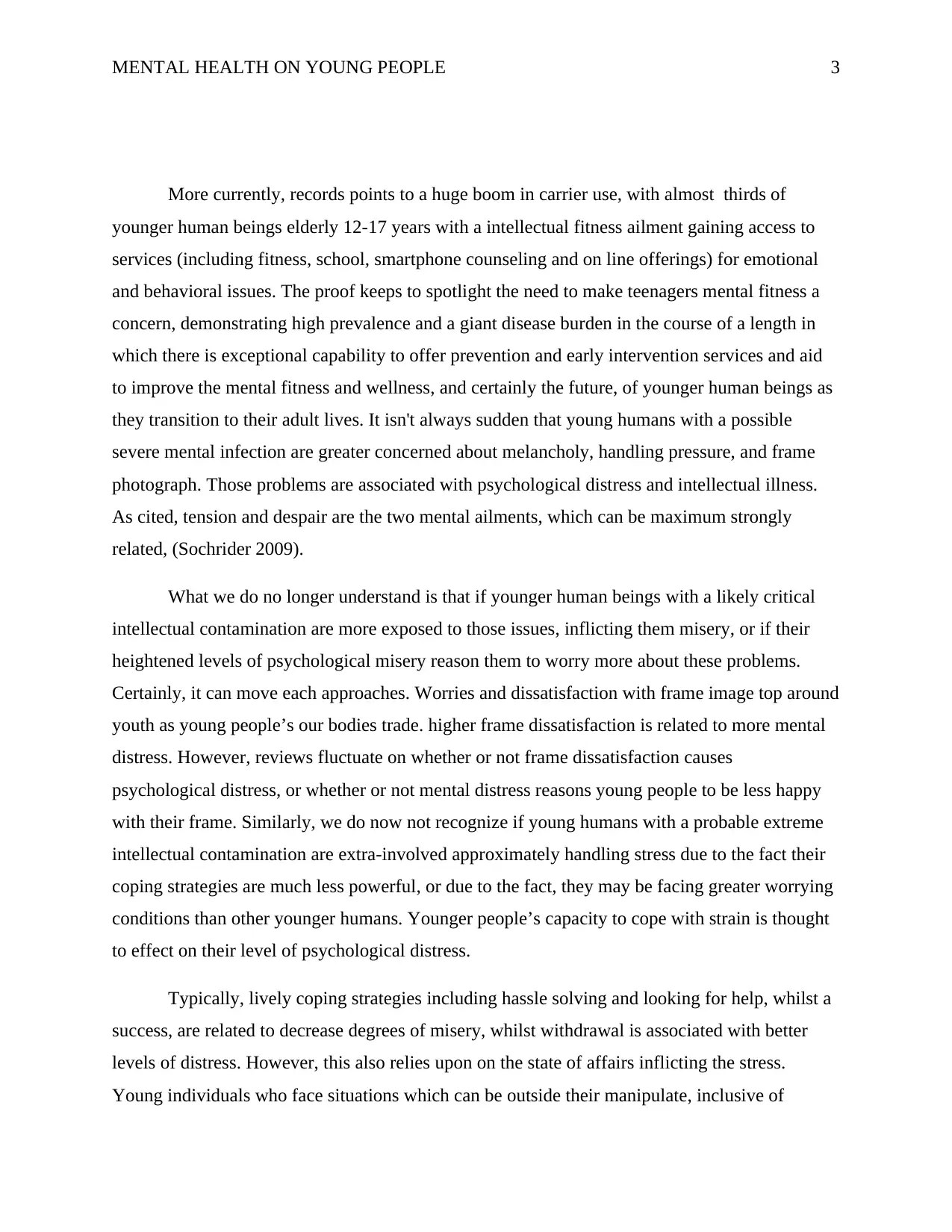
MENTAL HEALTH ON YOUNG PEOPLE 3
More currently, records points to a huge boom in carrier use, with almost thirds of
younger human beings elderly 12-17 years with a intellectual fitness ailment gaining access to
services (including fitness, school, smartphone counseling and on line offerings) for emotional
and behavioral issues. The proof keeps to spotlight the need to make teenagers mental fitness a
concern, demonstrating high prevalence and a giant disease burden in the course of a length in
which there is exceptional capability to offer prevention and early intervention services and aid
to improve the mental fitness and wellness, and certainly the future, of younger human beings as
they transition to their adult lives. It isn't always sudden that young humans with a possible
severe mental infection are greater concerned about melancholy, handling pressure, and frame
photograph. Those problems are associated with psychological distress and intellectual illness.
As cited, tension and despair are the two mental ailments, which can be maximum strongly
related, (Sochrider 2009).
What we do no longer understand is that if younger human beings with a likely critical
intellectual contamination are more exposed to those issues, inflicting them misery, or if their
heightened levels of psychological misery reason them to worry more about these problems.
Certainly, it can move each approaches. Worries and dissatisfaction with frame image top around
youth as young people’s our bodies trade. higher frame dissatisfaction is related to more mental
distress. However, reviews fluctuate on whether or not frame dissatisfaction causes
psychological distress, or whether or not mental distress reasons young people to be less happy
with their frame. Similarly, we do now not recognize if young humans with a probable extreme
intellectual contamination are extra-involved approximately handling stress due to the fact their
coping strategies are much less powerful, or due to the fact, they may be facing greater worrying
conditions than other younger humans. Younger people’s capacity to cope with strain is thought
to effect on their level of psychological distress.
Typically, lively coping strategies including hassle solving and looking for help, whilst a
success, are related to decrease degrees of misery, whilst withdrawal is associated with better
levels of distress. However, this also relies upon on the state of affairs inflicting the stress.
Young individuals who face situations which can be outside their manipulate, inclusive of
More currently, records points to a huge boom in carrier use, with almost thirds of
younger human beings elderly 12-17 years with a intellectual fitness ailment gaining access to
services (including fitness, school, smartphone counseling and on line offerings) for emotional
and behavioral issues. The proof keeps to spotlight the need to make teenagers mental fitness a
concern, demonstrating high prevalence and a giant disease burden in the course of a length in
which there is exceptional capability to offer prevention and early intervention services and aid
to improve the mental fitness and wellness, and certainly the future, of younger human beings as
they transition to their adult lives. It isn't always sudden that young humans with a possible
severe mental infection are greater concerned about melancholy, handling pressure, and frame
photograph. Those problems are associated with psychological distress and intellectual illness.
As cited, tension and despair are the two mental ailments, which can be maximum strongly
related, (Sochrider 2009).
What we do no longer understand is that if younger human beings with a likely critical
intellectual contamination are more exposed to those issues, inflicting them misery, or if their
heightened levels of psychological misery reason them to worry more about these problems.
Certainly, it can move each approaches. Worries and dissatisfaction with frame image top around
youth as young people’s our bodies trade. higher frame dissatisfaction is related to more mental
distress. However, reviews fluctuate on whether or not frame dissatisfaction causes
psychological distress, or whether or not mental distress reasons young people to be less happy
with their frame. Similarly, we do now not recognize if young humans with a probable extreme
intellectual contamination are extra-involved approximately handling stress due to the fact their
coping strategies are much less powerful, or due to the fact, they may be facing greater worrying
conditions than other younger humans. Younger people’s capacity to cope with strain is thought
to effect on their level of psychological distress.
Typically, lively coping strategies including hassle solving and looking for help, whilst a
success, are related to decrease degrees of misery, whilst withdrawal is associated with better
levels of distress. However, this also relies upon on the state of affairs inflicting the stress.
Young individuals who face situations which can be outside their manipulate, inclusive of
⊘ This is a preview!⊘
Do you want full access?
Subscribe today to unlock all pages.

Trusted by 1+ million students worldwide
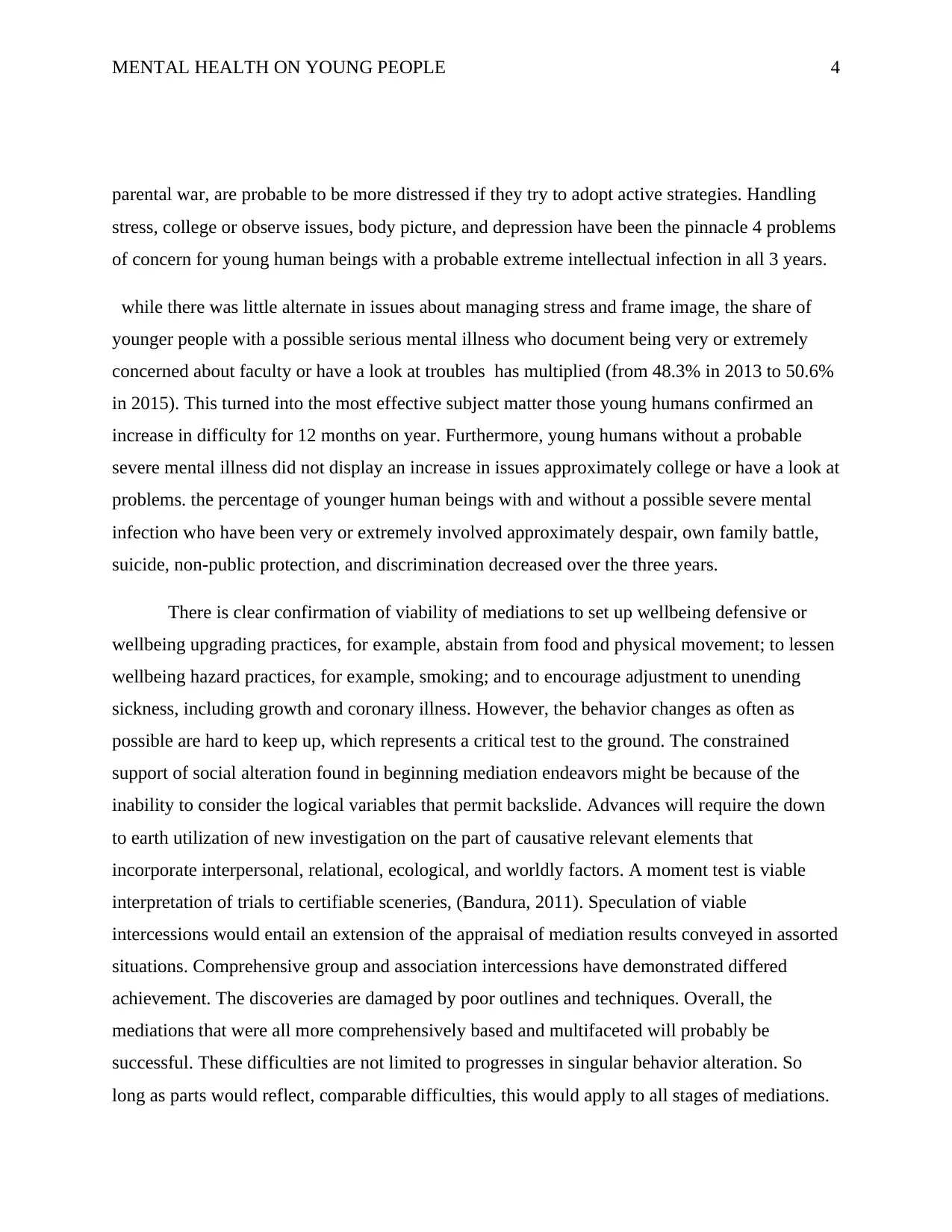
MENTAL HEALTH ON YOUNG PEOPLE 4
parental war, are probable to be more distressed if they try to adopt active strategies. Handling
stress, college or observe issues, body picture, and depression have been the pinnacle 4 problems
of concern for young human beings with a probable extreme intellectual infection in all 3 years.
while there was little alternate in issues about managing stress and frame image, the share of
younger people with a possible serious mental illness who document being very or extremely
concerned about faculty or have a look at troubles has multiplied (from 48.3% in 2013 to 50.6%
in 2015). This turned into the most effective subject matter those young humans confirmed an
increase in difficulty for 12 months on year. Furthermore, young humans without a probable
severe mental illness did not display an increase in issues approximately college or have a look at
problems. the percentage of younger human beings with and without a possible severe mental
infection who have been very or extremely involved approximately despair, own family battle,
suicide, non-public protection, and discrimination decreased over the three years.
There is clear confirmation of viability of mediations to set up wellbeing defensive or
wellbeing upgrading practices, for example, abstain from food and physical movement; to lessen
wellbeing hazard practices, for example, smoking; and to encourage adjustment to unending
sickness, including growth and coronary illness. However, the behavior changes as often as
possible are hard to keep up, which represents a critical test to the ground. The constrained
support of social alteration found in beginning mediation endeavors might be because of the
inability to consider the logical variables that permit backslide. Advances will require the down
to earth utilization of new investigation on the part of causative relevant elements that
incorporate interpersonal, relational, ecological, and worldly factors. A moment test is viable
interpretation of trials to certifiable sceneries, (Bandura, 2011). Speculation of viable
intercessions would entail an extension of the appraisal of mediation results conveyed in assorted
situations. Comprehensive group and association intercessions have demonstrated differed
achievement. The discoveries are damaged by poor outlines and techniques. Overall, the
mediations that were all more comprehensively based and multifaceted will probably be
successful. These difficulties are not limited to progresses in singular behavior alteration. So
long as parts would reflect, comparable difficulties, this would apply to all stages of mediations.
parental war, are probable to be more distressed if they try to adopt active strategies. Handling
stress, college or observe issues, body picture, and depression have been the pinnacle 4 problems
of concern for young human beings with a probable extreme intellectual infection in all 3 years.
while there was little alternate in issues about managing stress and frame image, the share of
younger people with a possible serious mental illness who document being very or extremely
concerned about faculty or have a look at troubles has multiplied (from 48.3% in 2013 to 50.6%
in 2015). This turned into the most effective subject matter those young humans confirmed an
increase in difficulty for 12 months on year. Furthermore, young humans without a probable
severe mental illness did not display an increase in issues approximately college or have a look at
problems. the percentage of younger human beings with and without a possible severe mental
infection who have been very or extremely involved approximately despair, own family battle,
suicide, non-public protection, and discrimination decreased over the three years.
There is clear confirmation of viability of mediations to set up wellbeing defensive or
wellbeing upgrading practices, for example, abstain from food and physical movement; to lessen
wellbeing hazard practices, for example, smoking; and to encourage adjustment to unending
sickness, including growth and coronary illness. However, the behavior changes as often as
possible are hard to keep up, which represents a critical test to the ground. The constrained
support of social alteration found in beginning mediation endeavors might be because of the
inability to consider the logical variables that permit backslide. Advances will require the down
to earth utilization of new investigation on the part of causative relevant elements that
incorporate interpersonal, relational, ecological, and worldly factors. A moment test is viable
interpretation of trials to certifiable sceneries, (Bandura, 2011). Speculation of viable
intercessions would entail an extension of the appraisal of mediation results conveyed in assorted
situations. Comprehensive group and association intercessions have demonstrated differed
achievement. The discoveries are damaged by poor outlines and techniques. Overall, the
mediations that were all more comprehensively based and multifaceted will probably be
successful. These difficulties are not limited to progresses in singular behavior alteration. So
long as parts would reflect, comparable difficulties, this would apply to all stages of mediations.
Paraphrase This Document
Need a fresh take? Get an instant paraphrase of this document with our AI Paraphraser
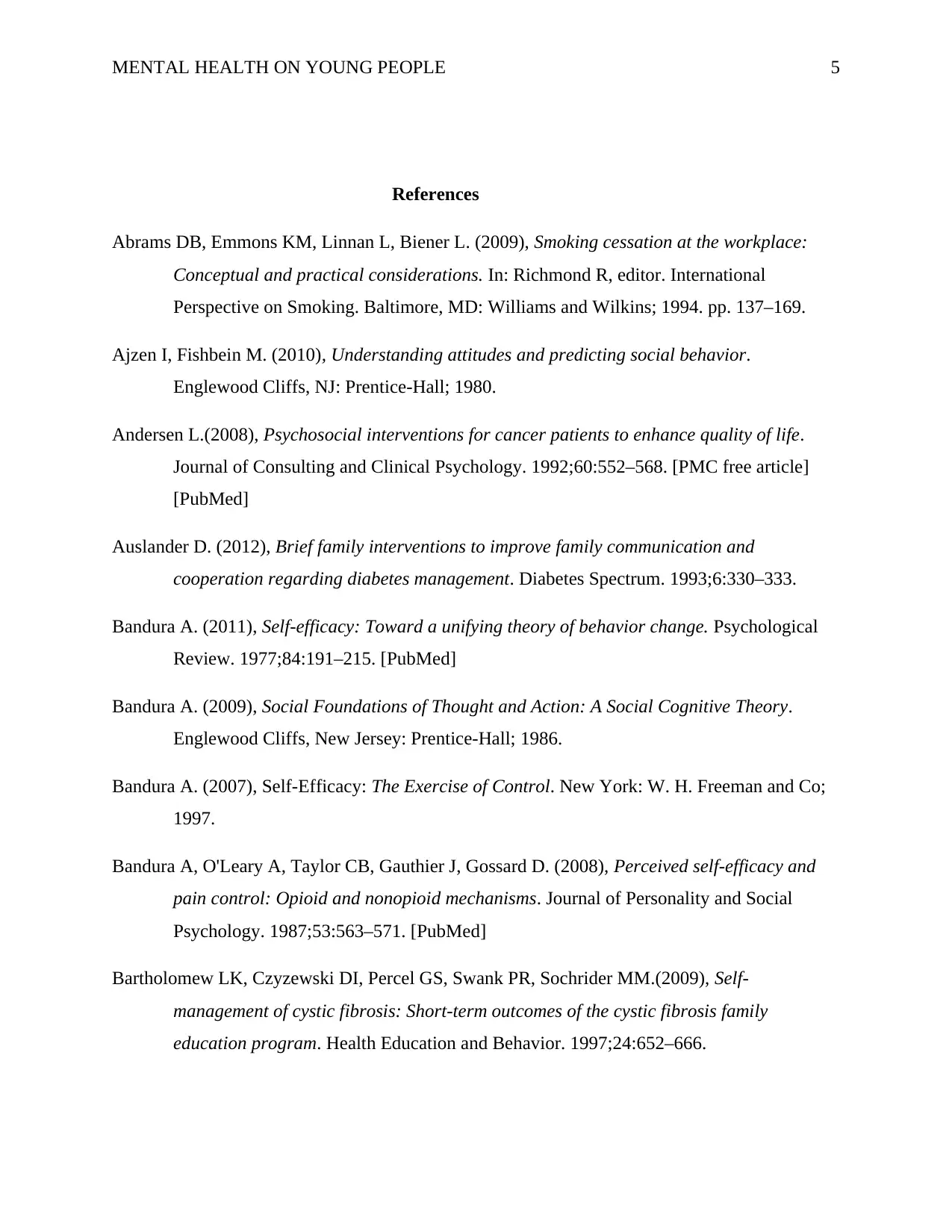
MENTAL HEALTH ON YOUNG PEOPLE 5
References
Abrams DB, Emmons KM, Linnan L, Biener L. (2009), Smoking cessation at the workplace:
Conceptual and practical considerations. In: Richmond R, editor. International
Perspective on Smoking. Baltimore, MD: Williams and Wilkins; 1994. pp. 137–169.
Ajzen I, Fishbein M. (2010), Understanding attitudes and predicting social behavior.
Englewood Cliffs, NJ: Prentice-Hall; 1980.
Andersen L.(2008), Psychosocial interventions for cancer patients to enhance quality of life.
Journal of Consulting and Clinical Psychology. 1992;60:552–568. [PMC free article]
[PubMed]
Auslander D. (2012), Brief family interventions to improve family communication and
cooperation regarding diabetes management. Diabetes Spectrum. 1993;6:330–333.
Bandura A. (2011), Self-efficacy: Toward a unifying theory of behavior change. Psychological
Review. 1977;84:191–215. [PubMed]
Bandura A. (2009), Social Foundations of Thought and Action: A Social Cognitive Theory.
Englewood Cliffs, New Jersey: Prentice-Hall; 1986.
Bandura A. (2007), Self-Efficacy: The Exercise of Control. New York: W. H. Freeman and Co;
1997.
Bandura A, O'Leary A, Taylor CB, Gauthier J, Gossard D. (2008), Perceived self-efficacy and
pain control: Opioid and nonopioid mechanisms. Journal of Personality and Social
Psychology. 1987;53:563–571. [PubMed]
Bartholomew LK, Czyzewski DI, Percel GS, Swank PR, Sochrider MM.(2009), Self-
management of cystic fibrosis: Short-term outcomes of the cystic fibrosis family
education program. Health Education and Behavior. 1997;24:652–666.
References
Abrams DB, Emmons KM, Linnan L, Biener L. (2009), Smoking cessation at the workplace:
Conceptual and practical considerations. In: Richmond R, editor. International
Perspective on Smoking. Baltimore, MD: Williams and Wilkins; 1994. pp. 137–169.
Ajzen I, Fishbein M. (2010), Understanding attitudes and predicting social behavior.
Englewood Cliffs, NJ: Prentice-Hall; 1980.
Andersen L.(2008), Psychosocial interventions for cancer patients to enhance quality of life.
Journal of Consulting and Clinical Psychology. 1992;60:552–568. [PMC free article]
[PubMed]
Auslander D. (2012), Brief family interventions to improve family communication and
cooperation regarding diabetes management. Diabetes Spectrum. 1993;6:330–333.
Bandura A. (2011), Self-efficacy: Toward a unifying theory of behavior change. Psychological
Review. 1977;84:191–215. [PubMed]
Bandura A. (2009), Social Foundations of Thought and Action: A Social Cognitive Theory.
Englewood Cliffs, New Jersey: Prentice-Hall; 1986.
Bandura A. (2007), Self-Efficacy: The Exercise of Control. New York: W. H. Freeman and Co;
1997.
Bandura A, O'Leary A, Taylor CB, Gauthier J, Gossard D. (2008), Perceived self-efficacy and
pain control: Opioid and nonopioid mechanisms. Journal of Personality and Social
Psychology. 1987;53:563–571. [PubMed]
Bartholomew LK, Czyzewski DI, Percel GS, Swank PR, Sochrider MM.(2009), Self-
management of cystic fibrosis: Short-term outcomes of the cystic fibrosis family
education program. Health Education and Behavior. 1997;24:652–666.
1 out of 5
Related Documents
Your All-in-One AI-Powered Toolkit for Academic Success.
+13062052269
info@desklib.com
Available 24*7 on WhatsApp / Email
![[object Object]](/_next/static/media/star-bottom.7253800d.svg)
Unlock your academic potential
Copyright © 2020–2025 A2Z Services. All Rights Reserved. Developed and managed by ZUCOL.




